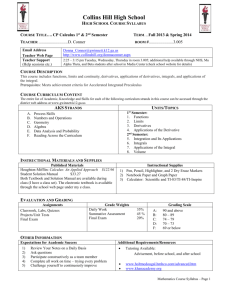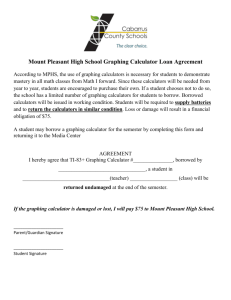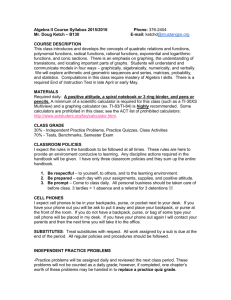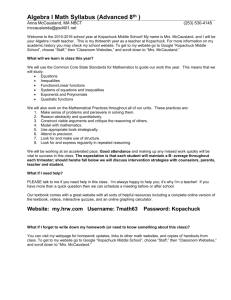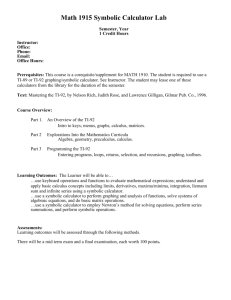AP stats syllabus - Issaquah Connect
advertisement
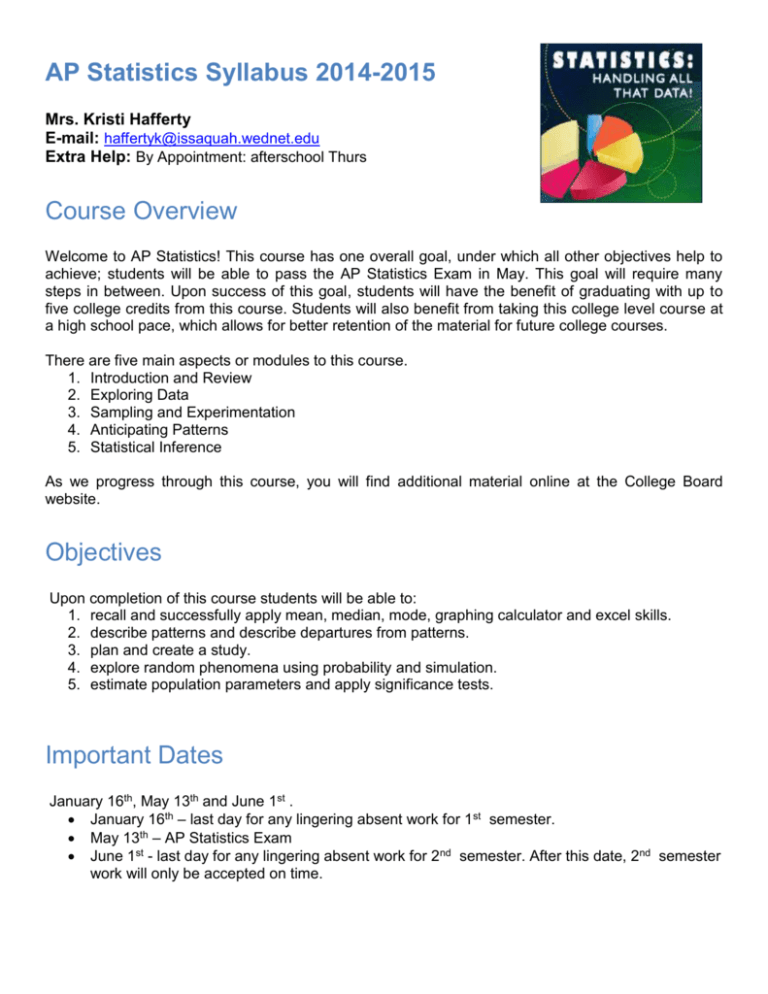
AP Statistics Syllabus 2014-2015 Mrs. Kristi Hafferty E-mail: haffertyk@issaquah.wednet.edu Extra Help: By Appointment: afterschool Thurs Course Overview Welcome to AP Statistics! This course has one overall goal, under which all other objectives help to achieve; students will be able to pass the AP Statistics Exam in May. This goal will require many steps in between. Upon success of this goal, students will have the benefit of graduating with up to five college credits from this course. Students will also benefit from taking this college level course at a high school pace, which allows for better retention of the material for future college courses. There are five main aspects or modules to this course. 1. Introduction and Review 2. Exploring Data 3. Sampling and Experimentation 4. Anticipating Patterns 5. Statistical Inference As we progress through this course, you will find additional material online at the College Board website. Objectives Upon completion of this course students will be able to: 1. recall and successfully apply mean, median, mode, graphing calculator and excel skills. 2. describe patterns and describe departures from patterns. 3. plan and create a study. 4. explore random phenomena using probability and simulation. 5. estimate population parameters and apply significance tests. Important Dates January 16th, May 13th and June 1st . January 16th – last day for any lingering absent work for 1st semester. May 13th – AP Statistics Exam June 1st - last day for any lingering absent work for 2nd semester. After this date, 2nd semester work will only be accepted on time. Textbooks There are two main textbooks you will read for both informational purposes and to access problems to apply your statistical knowledge. The first book is the main text written by Starnes, Yates and Moore. This text will thoroughly guide you through all the statistics information you need for the AP Statistics Exam. The main author, Daren Starnes, is one of the leaders during the AP grading process and also works closely with Princeton University. I met with him during my AP Statistics training during the summer. The second text, Barron's, is a book that does additional summary of the AP topics we will be studying. It also contains five practice exams. As we progress through the school year, I will be assigning problems from this text as you become ready for certain topics. Grading Policy The grade you earn will be based upon the subsequent criteria: 42% Midterms and Finals 42% Quizzes 16% Homework The grading scale for report cards will be based on the point system below. Rounding to the nearest whole number will be used when determining the letter grade. To find out your current grade, parents and students can always utilize Family Access to see your student’s grades at any time. I update grades after each unit exam has been graded, if not sooner. I will send an e-mail report after such a time, so check to be sure your e-mail address is current and correct on Family Access. A AB+ B BC+ C CD+ D F 93%-100% 90%-92% 87%-89% 83%-86% 80%-82% 77%-79% 73%-76% 70%-72% 67%-69% 60%-66% 0%-59% 2 AP Statistics Syllabus Midterms/Finals Five midterms will be given throughout the course: after chapters 4, 6, 7, 9 and 12. Each exam will have two parts like the real AP Exam; a multiple choice component and a free response component. Each midterm is cumulative. Each exam will be curved. Quizzes Quizzes will be given regularly. The concepts they will cover the standards set by the College Board for the AP Statistics exam. At the end of the semester, the two lowest quiz grades will be dropped by the computer. Homework Homework will be assigned regularly and is important for you to do it to make sure you understand the concepts covered in class before you take a quiz, a midterm or the real AP Exam. Always check your work for accuracy. If you do any application problem incorrectly, then be sure to find out what went wrong. Don't leave answers incorrect as you don't learn anything from that. Some homework will be in the form of projects. Other homework could be in class daily work. Absences All absent work must be turned in within one week, seven days, upon return. This includes a test that was missed, which can be made up after school or Wednesday mornings. However, work can only be made up if an excused absence was involved. When a student is absent, it becomes his/her responsibility to find out what was missed. To help you find out what was missed from an absence, you can check the course website, talk to a group member or refer to your unit calendar. Until work is completed and turned in, a 0 is entered into the grade book. Late Work Unexcused late work will only be accepted with for half credit before the completion of the chapter. Students may turn in 5 late assignments per semester. 3 AP Statistics Syllabus Supplies for Statistics All students should have a graph paper notebook, a graphing calculator, a space in a 3-ring binder for AP Stats, a computer and internet access available at home for this course. Graphing calculators can be rented if you do not want to purchase one. Computers are available after school in the Library or Computer Labs. Calculators For AP Statistic students, it is a requirement to own a graphing calculator. There will be many assignments where a graphing calculator shall be needed at home. If you need to buy a new one, you should purchase the TI-Nspire (color with backlight a great option!). Classroom Rules All school rules will be enforced within the classroom. This includes the district’s attendance policy. There is no gum, no food and no drinks. Water is acceptable in a container with a lid to prevent spills. Use of electronic device is forbidden! In fact, using any electronic devices in class, such as iPod or a cell phone will result in immediate confiscation. For the first offense, the object will be kept until the end of the day. For a second offense, the device will be confiscated until after the upcoming weekend. I will also consider calling your parents and/or turn it over to an administrator where you can pick it up and explain why you felt it was necessary to disrupt class with it. Extra Credit Extra credit is only assigned by the teacher and offered to the entire class. There are no instances in which an individual can earn special extra credit. Special requests for extra credit cannot be met. Students should be completing work as it is assigned in order to be successful on future assignments and exams. Plagiarism Policy Copying someone else’s work will not be tolerated and will result in the following consequences. All involved students will receive a zero for the work. This includes those who copied and those who allowed the copying. A zero will be entered into the grade book. Copies of the work shall be placed in each student’s file along with a referral for future reference. It is simply not worth it! 4 AP Statistics Syllabus


